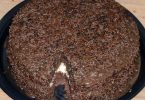
Ingredients
Nonstick baking spray, for the cake pans
4 1/2 cups all-purpose flour
2 1/4 teaspoons baking powder
3/4 teaspoon kosher salt
3 cups granulated sugar
3 sticks (12 ounces) unsalted butter, at room temperature
6 large eggs, at room temperature
4 1/2 teaspoons pure vanilla extract
2 cups whole milk, at room temperature
Red, orange, yellow,
green, blue and purple gel food coloring, as needed
2 recipes Buttercream Frosting, recipe follows
1 recipe Mirror Glaze, recipe follows
Buttercream Frosting:
4 cups confectioners’ sugar
2 sticks (8 ounces) unsalted butter, at room temperature
Pinch kosher salt
2 teaspoons vanilla extract
1 to 2 tablespoons milk
Mirror Glaze:
2 1/4 teaspoons unflavored powdered gelatin
1 cup granulated sugar
1/3 cup light corn syrup
1 cup good-quality white chocolate disks or chopped white chocolate
1/2 cup sweetened condensed milk
Assorted colors of gel food coloring, as desired
Directions
Special equipment:
two 8-inch cake pans; an 8-inch cake board; an instant-read thermometer; an immersion blender
• Preheat the oven to 350 degrees F. Spray two 8-inch cake pans with baking spray and line the bottoms with parchment rounds.
• Whisk together the flour, baking powder and salt in a bowl. Beat the granulated sugar and butter in a stand mixer fitted with the paddle attachment on medium-high speed until fluffy, about 4 minutes. Beat in the eggs one at a time, scraping down the bowl as needed. Beat in the vanilla. Reduce the mixer speed to medium low; beat in half the flour mixture, then all of the milk and then the remaining flour mixture until just combined.
• Separate the batter into 6 different bowls and tint one bowl red, one orange, one yellow, one green, one blue and one purple. Transfer each color to a separate disposable pastry bag or resealable ziptop bag. Pipe half of the red batter into the center of one of the prepared pans, then pipe the remaining red batter into the center of the second pan. Pipe half the orange batter into the center of the red batter in the first pan, then repeat with the remaining orange batter in the second pan, tapping the pans gently as needed to level out the batter. Repeat with the remaining colored batter until all the batter is piped and both cake pans are about half full.
• Bake, rotating the pans halfway through, until a toothpick inserted in the center of a cake comes out clean, 40 to 45 minutes. Transfer the pans to a rack and let cool 10 minutes, then invert the cakes onto a wire rack and cool completely.
• To decorate: Using a serrated knife, level the top of each cake layer. Spread a small amount of Buttercream Frosting onto an 8-inch cake board. Place one cake layer onto the cake board bottom-side up. Add about 1/2 cup of frosting to the top of the cake and smooth to an even layer. Invert the second cake layer over top of the frosting layer. Using an offset spatula, frost the cake with an even coat of frosting. Refrigerate to set and chill, about 3 hours.
• Place the chilled cake onto a wire rack fitted inside a baking sheet. When the Mirror Glaze is the proper temperature, pour the colors together into a single container for a swirled effect. Pour the glaze over the cake, then let it stand to set before transferring to a cake stand.
Buttercream Frosting:
• Combine the confectioners’ sugar, butter and salt in the bowl of a stand mixer fitted with a paddle attachment. Mix on low speed until mostly incorporated. Add the vanilla, increase the speed to medium high and mix until smooth. Adjust the consistency with milk as desired.
Mirror Glaze:
• Whisk together the gelatin and 3 tablespoons water in a small bowl; set aside to bloom.
• Combine the granulated sugar, corn syrup and 1/3 cup water in a medium saucepan. Bring to a boil and cook until the sugar is dissolved and the mixture is clear, about 2 minutes.
• Remove the saucepan from the heat and whisk in the bloomed gelatin to dissolve. Add the white chocolate and let stand 1 minute to melt. Add the condensed milk and combine with an immersion blender until emulsified and smooth.
• Divide the glaze into bowls and color as desired. When the glaze is between 75 and 80 degrees F, it is ready to pour.







Leave a Comment